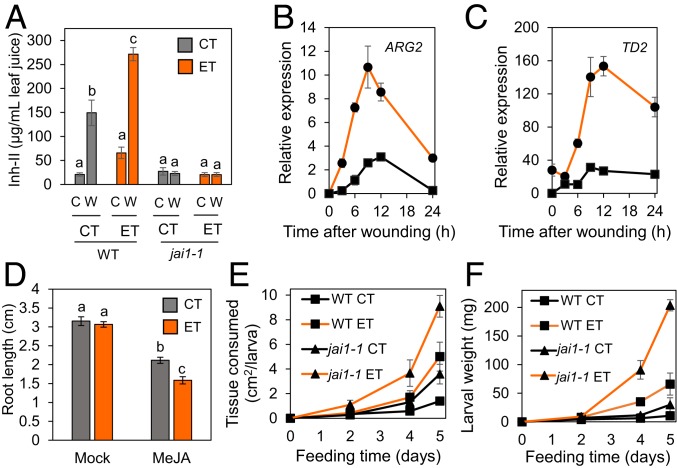Fig. 1.
Elevated temperature enhances JA responses and insect feeding. (A) Inh-II levels in leaves of wounded (W) and undamaged control (C) plants. Wild-type and jasmonate-insensitive1 (jai1-1) tomato plants grown for 17 d under the CT regime (28 °C 16 h light/18 °C 8 h dark) were transferred to either CT or ET (38 °C 16 h light/28 °C 8 h dark). Five days after transfer to CT or ET treatment chambers, leaves were mechanically wounded. Inh-II levels in the damaged leaves were measured 24 h after wounding. Data points represent the mean ± SE of four biological replicates. Lowercase letters denote significant differences (Tukey’s honestly significant difference [HSD] test P < 0.05). (B and C) Time course of wound-induced transcript accumulation of two JA-responsive genes, ARG2 (B) and TD2 (C). WT plants were grown as described in A and transferred to CT or ET treatment chambers for 2 d prior to wounding. Leaf tissue was harvested for RNA extraction at the indicated times after wounding. ARG2 and TD2 mRNA levels were determined by qPCR, with normalization to an ACTIN housekeeping gene. Data points represent the mean ± SE of four biological replicates. (D) Effect of ET on JA-mediated root growth inhibition. WT seeds were germinated at ambient temperature (22 °C) on filter paper prior to treatment with 1 mM MeJA or mock control (mock), followed by immediate transfer to CT or ET conditions for 2 d. Data points represent the mean ± SE of >30 seedlings. Lowercase letters denote significant differences (Tukey’s HSD test P < 0.05). (E and F) Insect feeding assays on WT and jai1-1 plants under CT or ET conditions. Seventeen-day-old WT and jai1-1 plants grown under CT conditions were transferred to CT or ET treatment chambers for 5 d prior to challenge with two M. sexta larva per leaf. Feeding proceeded at either CT or ET. The amount of leaf area consumed per larva (E) and larval weight gain (F) were measured at the indicated times after challenge. Data points represent the mean ± SE of three biological replicates.

